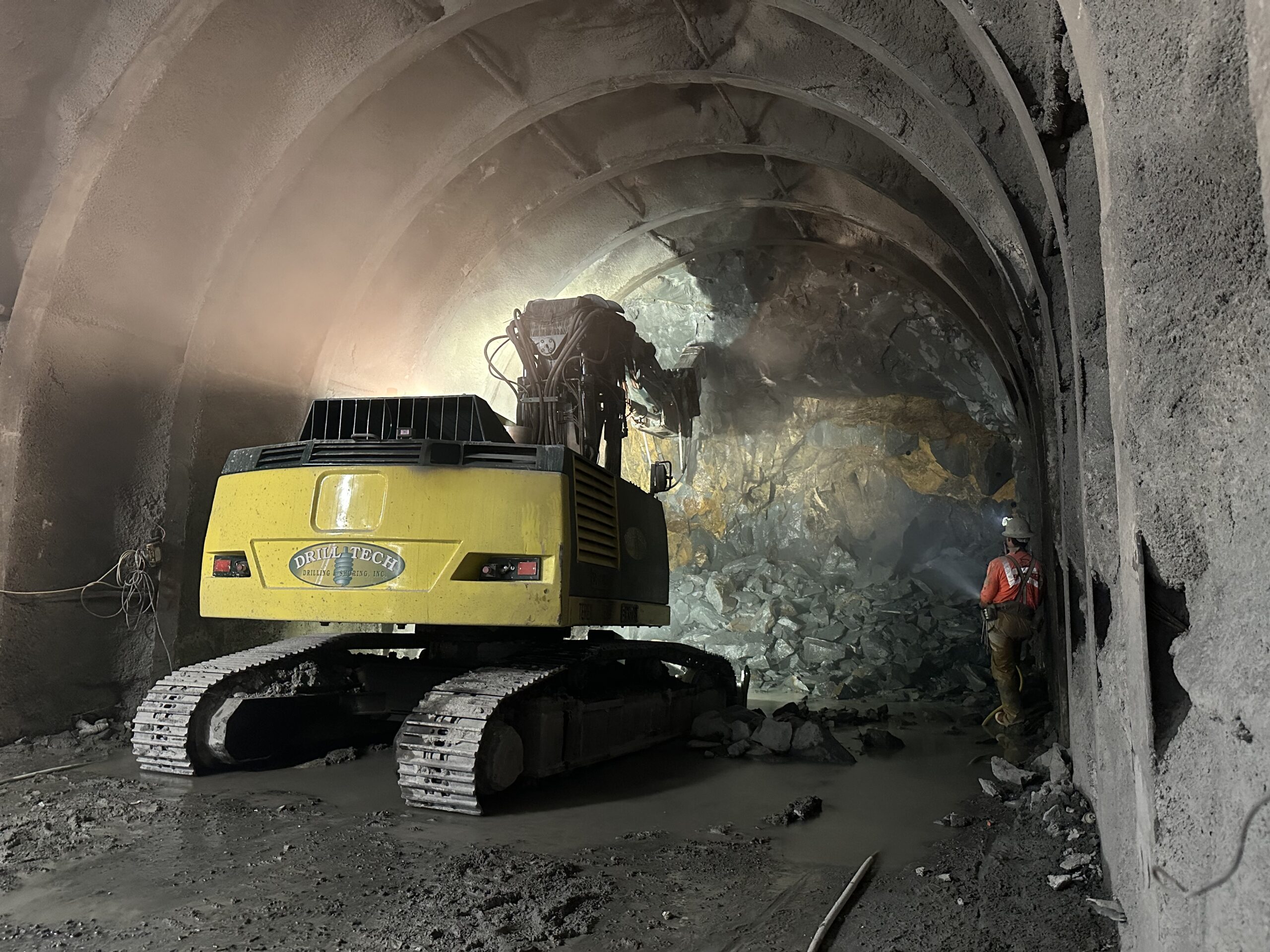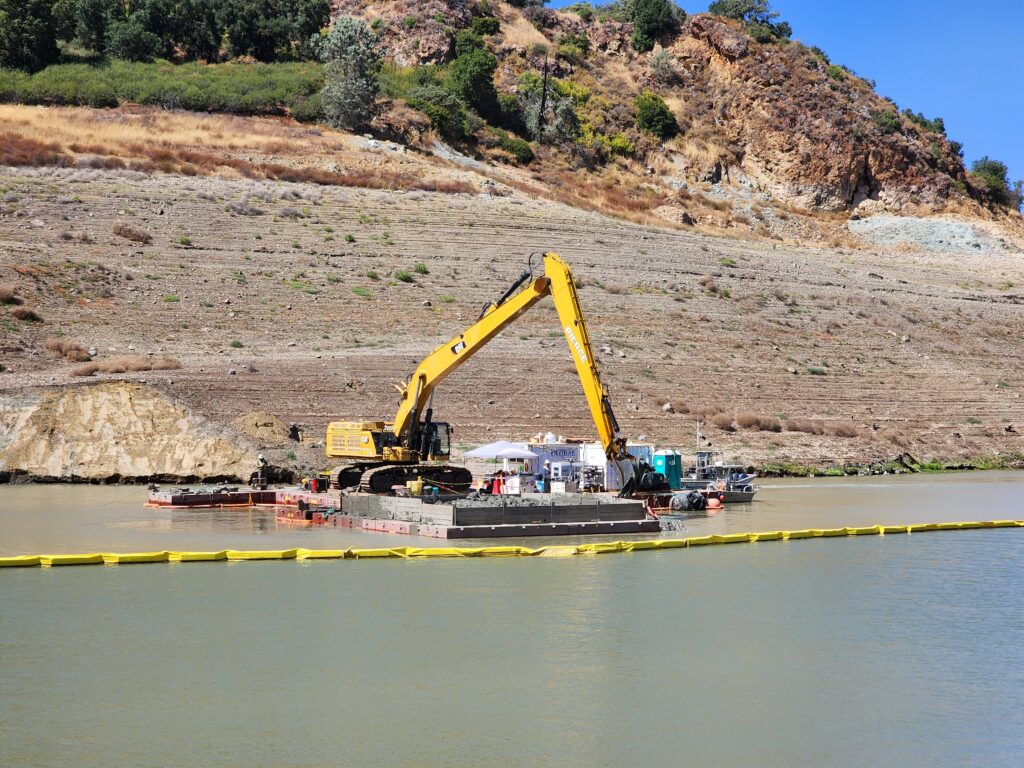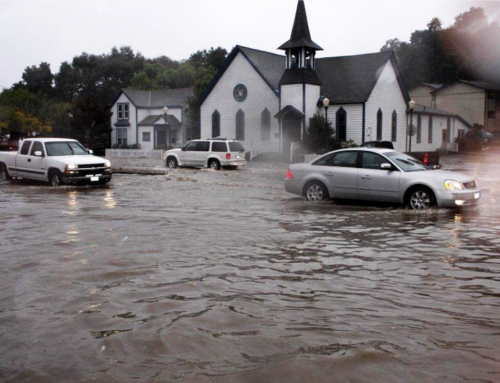Estimated price tag is now more than triple 2021 projection of $648 million
![]()

Photo courtesy Valley Water A tunnel-digging machine using a hydraulic hammer excavates hard rock in a tunnel of Anderson Dam.
By Kaylee Arca
A seismic shakeup over the Anderson Dam Retrofit Project rattled Santa Clara County earlier this month as the estimated cost to rebuild the 73-year-old structure surged to $2.3 billion — more than triple initial projections.
Valley Water engineer Ryan McCarter shared the update at the Santa Clara County Water Board of Directors meeting Tuesday, Nov. 14. It elicited urgency to avoid further burdening ratepayers for the ballooning project.
Photo courtesy Valley Water An excavator on a barge dredges the bottom of Anderson Reservoir about 30 feet below the surface of the water.“I’m mad as hell and I can’t take it anymore,” said John Varela, the board chair and the director of District 1, which includes South Valley. “This project is becoming a very frustrating project for our board. Costs continue to rise, but that’s a sign of the times across the country, due to inflation.”
When Valley Water contractors started construction on the project in 2021, engineers estimated it would take a decade and $648 million to complete. The price tag nearly doubled in January 2022 when Valley Water announced the cost rose to $1.2 billion. With this month’s announcement of an estimated $2.3 billion cost, it nearly doubled again.
Valley Water says the cost estimate increased due to risk reduction measures, design development, and increased cost of materials and labor, in addition to inflation.
Adding to the cost, Valley Water also needed to modify the emergency spillway design due to comments from a board of consultants. The spillway length will extend 800 feet through a channel that will be lined with concrete.
“Your bathtub has a safe way to drain water before spilling out onto your bathroom floor,” McCarter said as a comparison for the spillway. “This will help us safely convey emergency spills in the future.”
The recent cost increase has forced Valley Water to start looking for additional funding sources.
“We’re really trying to map out what we think this project will cost as it goes into construction,” McCarter said. “We’re trying to predict what a construction bid would look like with all of the associated costs so we can plan our budget accordingly and set our water rates to make sure we’re geared up to cover these costs.”
Valley Water hopes to find additional funding to prevent raising its rates for its municipal customers, who in turn will be forced to pass on the price hike to their residential and business customers.
“We’re doing everything within reasonableness to work with our federal and state elected officials to find the funding mechanisms to help us cover the costs that are increasing,” Varela said. “We don’t want to pass these costs onto our ratepayers.”
A county-wide bond is one funding option that Valley Water is examining. If such a measure goes to a vote, an immense bond would be controversial among property owners, Varela said.
As inflation impacts the economy over time, the project will see potentially more cost increases in the future, predicted Mark Hinkle, a Morgan Hill resident who serves as the president of the Silicon Valley Taxpayers Association
“How can we, the customers relying on these public stewards for everything from our drinking water to flood control . . . trust that the bait-and-switch is over, that this cost escalation will be the final one?” he said. “(Valley Water’s) shortsightedness in forecasting the cost of the Anderson Dam project may soon morph into a bond, which means that what appears now to be a doubling of the original estimate could actually mushroom into a quadrupling. Bonds constitute 30–40 years of indebtedness, sometimes longer, and naturally, the lenders charge interest, usually doubling the total cost of a bond.”
Geologists discovered in 2011 two earthquake faultlines passing under the reservoir. Engineers later saw seismic stability issues in Anderson Dam. The federal government in 2020 ordered Valley Water to drain the reservoir to a three percent capacity to prevent catastrophic flooding of South Valley and San Jose in the event a major earthquake destroys the dam.
Experts estimate a magnitude 7.25 earthquake on the Calaveras Fault centered less than 1.25 miles from the dam, or a magnitude 6.6 earthquake on the Coyote Creek Fault centered beneath the dam, could lead to structural failure and a massive flood.
After Valley Water submitted project designs to the Federal Energy Regulatory Commission for approval, FERC split the retrofit into several smaller compliance projects for construction and conservation efforts.
The Anderson Dam Seismic Retrofit Project consists of: Coyote Creek flood management measures, Coyote Creek percolation dam replacement, cross valley pipeline extension, and Coyote Creek stream augmentation (chillers to cool the water for ecological protection downstream).
The four other projects are in the construction phase but need to be completed before breaking ground for the project. After the new dam’s design, environmental review, and permitting are finalized, groundbreaking is expected in 2026 and work completed in 2032.
Of the $2.3 billion, about $400 million is budgeted for the other four projects along Coyote Creek. An additional $500 million is budgeted for other environmental restoration, construction, design, real estate costs, and contingencies.
Regardless of the cost of building a new Anderson Dam, the project is important to provide a reliable source of water for the nearly two million people residing in Santa Clara County, Varela said.
“We’re on schedule,” Varela said. “The work that we’re doing is making great progress. This is the most important project in Valley Water at this time. We’re doing everything within reason to stay on the project, minimize overhead costs, and protect the citizens.”
Kaylee Arca is a Morgan Hill-based freelance writer.






